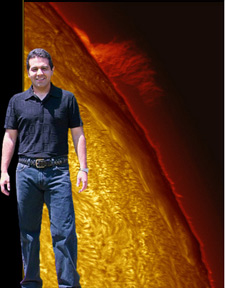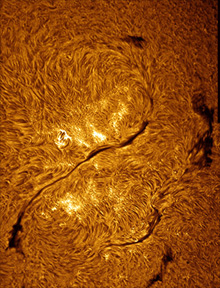My name is Larry Alvarez. My first experience with solar public outreach came in February of 2006. I had never thought about it before then. During 2005 I was focused on developing my craft and working towards producing the best possible image that I could with my equipment. I developed a solar roadmap to lead me in the direction of becoming a better solar photographer. By using sound methods and keeping a log of all the events taken, I found that over that year I did make progress and my images started looking better.
A friend of mine mentioned that there was a nice website to submit images to called www.spaceweather.com and pretty good ones might get posted. I had used the website in the past to locate spots before going outside to image them but never thought of submitting anything. I sent in a few before one finally got accepted and posted. To my surprise I got several e-mails from all over the world with kind words, encouragement, and questions on how I took the images.

I also got many from teachers that asked for images for their classes and for use in presentations they were making. The image also caught the eye of a local Astronomy teacher for R.L. Turner High School, Mrs. Bedie and she contacted me to see if I could come speak to her high school class. To be perfectly honest, public outreach can be very scary to someone that is an introvert, but my Solar Imaging road map called for getting involved with others and getting first-hand experience with others with the same interests. I figured this would be a perfect opportunity to do so. Sometimes the hardest things to do turn out to be the best for us.
Being relatively new to solar imaging and never having done this sort of thing I did not know what to expect. I knew that I would have to give a presentation so I asked to take a vacation day for the day it was on and my manager let me off to do it without having to take a vacation day! This was great for me so it was "all systems go" at that point. I decided to enlist the help of a couple friends that had done this sort of thing before to get some advice.
I met these friends online in a Solar Chat room on the Cloudy Nights web site. Besides sending me their advice and experiences, they also gave me some pointers on how to get setup and what to expect. This was, invaluable information to me. I quickly formulated a plan to let the students get a live view of the sun through my telescope at low power and high power and also do a presentation on how I got started. Mrs. Bedie also gave me some ideas on what to present to the class that helped my planning. I also wanted to keep things as simple as possible to avoid any complications.
I broke up the presentation into two parts. The first would be an oral presentation with a slide show of how I got started. In the presentation, I put high resolution images between each slide to keep things interesting. The second part was the live H-alpha solar view outside the classroom. Both friends warned me to have a back up plan just in case of bad weather, so I prepared a third segment that consisted of a gallery of images to show just in case the clouds came out. I quickly realized that I needed to figure out how much time I was going to spend on each segment. The class was just 45 minutes so I had to streamline my scope setup and polar alignment before hand so that I could do it fast.
I arrived at the school early for two main reasons. The first was setup my telescope on the sidewalk and mark the locations where the tripod feet were touching when it was polar aligned. The second reason was to get a close parking spot next to the viewing area. Now when the time came to setup I would not only have my equipment close but I could polar align the scope quickly and get to the viewing part of the presentation. I also brought just the bare essentials: the scope, a couple of eyepieces, a Barlow lens, the tripod, and a small card table to hold everything. At first I believed that I did not have enough material to present but once the presentation was in full swing I found that I had too much to say and not enough time to say it.
I ended up staying for two other classes because it was so much fun. I gave a 15~20 minute presentation and then we all went outside for a peek through my H-alpha solar telescope. To my surprise both segments, the oral presentation and the outside viewing session got several exciting responses. A week later I got a letter in the mail from Mrs. Bedie's classes thanking me for the presentation and taking the time show them the sun in a light that they had never seen before.
The letter also had a couple cards signed by all the students with well wishes and there was also a unique drawing that one student did that depicted the view of the H-alpha sun. It was and still is one of my favorite viewing sessions to date. The appreciation and the opportunity to bring the extraordinary view of the H-alpha sun to the students was well worth the preparation time. I would encourage anyone that has the opportunity to do something like this to do it.
My day-to-day schedule does not allow much time to do many extra activities but public outreach is definitely one that I will make time for in the future. Sharing the view with others on a larger scale is something I really enjoyed. We all had a blast looking at the sun that day. Since that time I have started developing more plans to further my presentation skills and develop a better viewing platform.
See more of my images at http://mysite.verizon.net/armicheal/.

TELL US ABOUT YOUR ACTIVITIES: If you use our SOHO images or movies, provide outreach and programs in the area of solar study, and would like to be considered for our Outreach Spotlight section, write to steele.hill[at]gsfc.nasa.gov with a brief overview of your efforts. If we think you'd make a good candidate, we will contact you.


